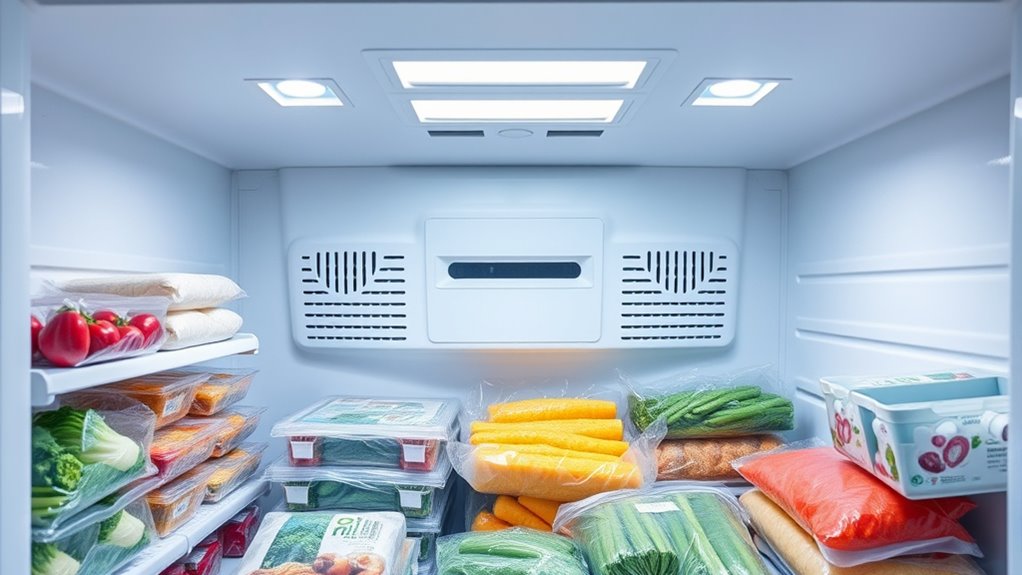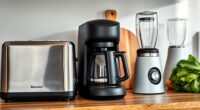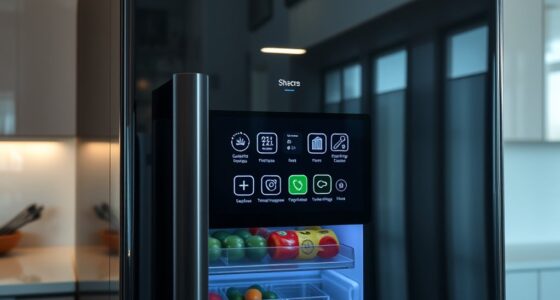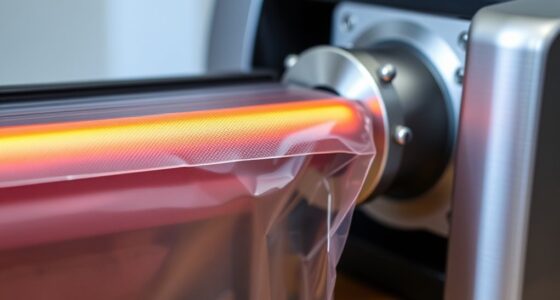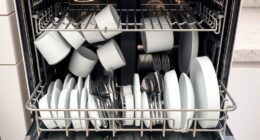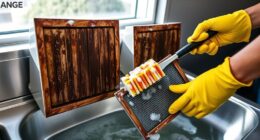To keep your freezer efficient, keep it filled to about 75-90%, but don’t overload or block airflow. Organize contents, use clear bins, and keep frequently used items at the front to minimize door openings. Place it in a well-ventilated spot, leaving space for proper heat dissipation. Manage ice buildup by defrosting when frost exceeds ¼ inch. For more tips on maintaining ideal load, airflow, and defrosting, stay tuned for practical guidance.
Key Takeaways
- Keep freezers filled to 75-90% capacity to prevent warm air entry and ensure efficient cooling.
- Ensure proper airflow by leaving 2-3 inches on sides and vents clear of obstructions.
- Defrost regularly when frost exceeds ¼ inch to maintain optimal heat transfer and energy efficiency.
- Organize items for quick access, reducing door openings and cold air loss.
- Use automatic defrost systems and modern insulation to minimize frost buildup and optimize energy use.
Optimal Load Levels for Energy Efficiency
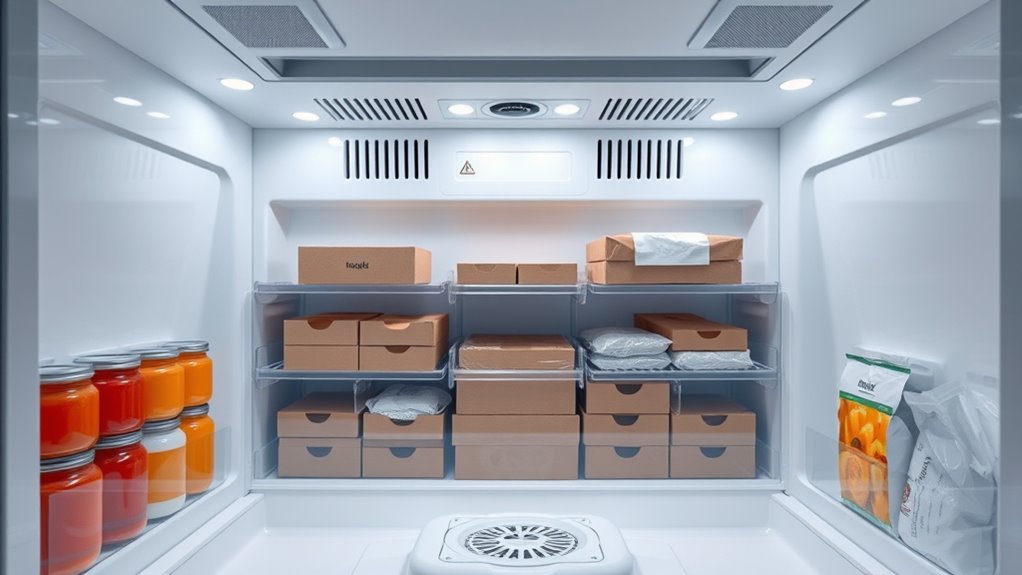
Maintaining the right load level is essential for maximizing freezer energy efficiency. When your freezer is filled to about 75%–90%, it reduces the amount of warm air that enters each time you open the door. The frozen contents help quickly re-cool any warm air that slips in, easing the compressor’s workload. Leaving it too empty causes the freezer to cool more air repeatedly, wasting energy. Conversely, overloading blocks airflow and sensors, which hampers performance. To keep efficiency high, organize items to guarantee proper air circulation and avoid blocking vents. Filling gaps with containers or packing materials maintains ideal load levels, preventing frost buildup and temperature fluctuations. Striking the right balance keeps your freezer running smoothly and saves energy. Proper airflow is also crucial for maintaining consistent temperatures and preventing energy waste.
Organizing Contents to Minimize Door Openings
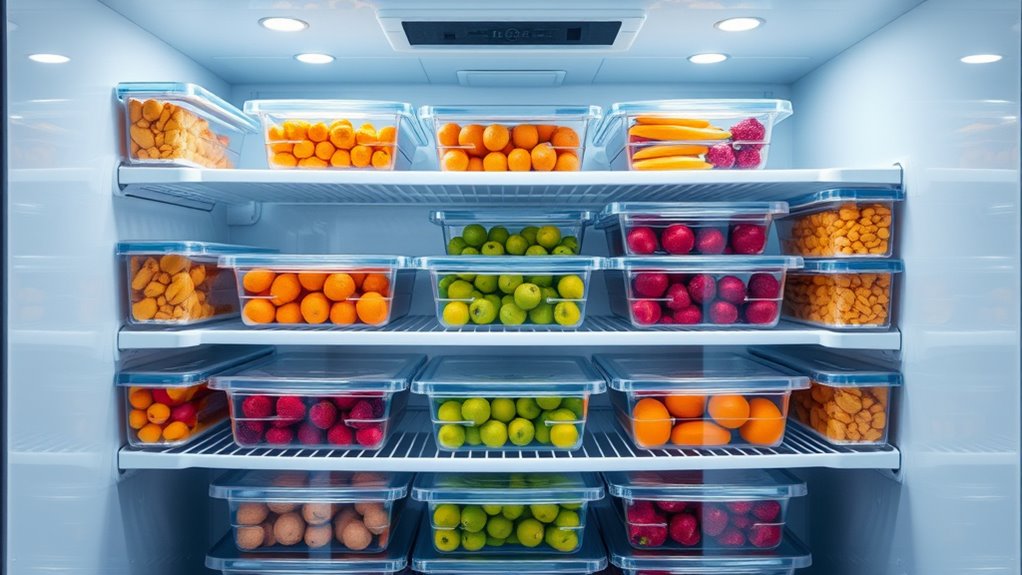
Organizing your freezer contents effectively can substantially reduce the number of door openings needed to find items. Clear visibility minimizes search time, so you waste less cold air each time you open the door. Group similar items or meals together to speed retrieval, and use transparent bins or labels for quick identification without prolonged exposure. Keep frequently used items at the front to avoid deep reaching. An outside inventory list helps plan what to take, cutting unnecessary openings. Designate zones for different foods or expiration dates to streamline access, and use stackable containers for better visibility. Avoid overloading shelves, leave space for airflow, and regularly defrost to prevent ice buildup. Efficient organization not only saves energy but also extends the lifespan of your freezer. Additionally, maintaining proper airflow within the freezer ensures consistent temperatures and optimal performance. Proper air circulation prevents cold spots and ice accumulation, further enhancing efficiency. These strategies help maintain consistent internal temperatures and improve freezer efficiency.
Proper Placement and Ventilation of Your Freezer
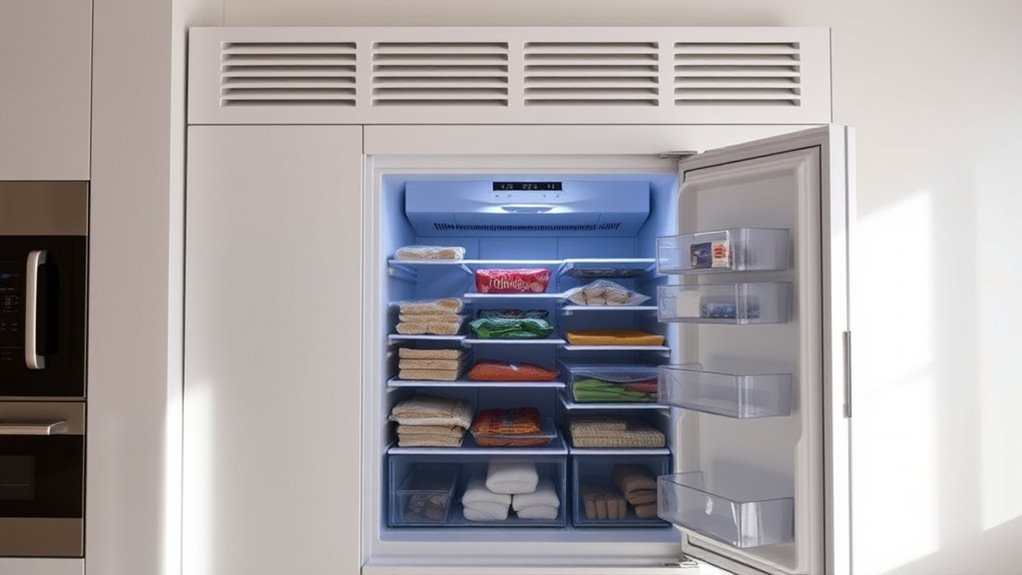
To keep your freezer running efficiently, make sure it’s placed in a dry, well-ventilated area away from heat sources like radiators or direct sunlight. Leave enough space around it—about 2 to 3 inches on the sides and at least 2 inches behind—for proper airflow and heat dissipation. Proper placement reduces strain on the compressor and helps maintain ideal temperature. Additionally, ensuring adequate airflow around your freezer is essential for optimal performance. Incorporating Kia Tuning techniques such as improved airflow management can also be beneficial for other vehicle systems, emphasizing the importance of ventilation in overall efficiency.
Ventilation Space Requirements
Proper placement and ventilation are crucial for ensuring your freezer operates efficiently and lasts longer. Adequate airflow prevents overheating and maintains peak performance. For integrated freezers, ensure at least 200 cm² of vent space at the front base for air intake. Rear and top-back panels need 500 mm x 40 mm vent gaps for airflow. Use vents or grilles in cabinetry to allow air behind and underneath the unit. Here’s a quick overview:
| Ventilation Requirement | Dimensions/Details |
|---|---|
| Front intake vent | Minimum 200 cm² |
| Rear base vent | 500 mm x 40 mm |
| Top-back vent | 500 mm x 40 mm |
Maintaining proper clearance and airflow paths improves efficiency and prolongs your freezer’s lifespan. Proper airflow management is essential for optimal freezer performance.
Placement Away From Heat
Placing your freezer away from heat sources helps it run efficiently and last longer. Keep it positioned far from radiators, baseboard heaters, cooking appliances, and direct sunlight, as these increase the compressor’s workload. Higher ambient temperatures slow heat dissipation from the condenser, causing longer operation and higher energy use. For outdoor or garage freezers, choose shaded, protected areas to prevent weather and sunlight from impacting performance. Avoid locations where temperatures exceed 110°F or fall below 0°F to prevent damage and ensure proper compressor function. Additionally, prevent placement near moist or water-prone areas to avoid rust and corrosion. Proper placement reduces strain on the freezer, improves cooling efficiency, and extends its lifespan. Considering the environmental conditions in your area can further optimize your freezer’s performance. Always consider the environment to keep your freezer running smoothly, and be mindful of home essentials to optimize appliance lifespan and performance.
Managing Ice Build-up and Frost Formation
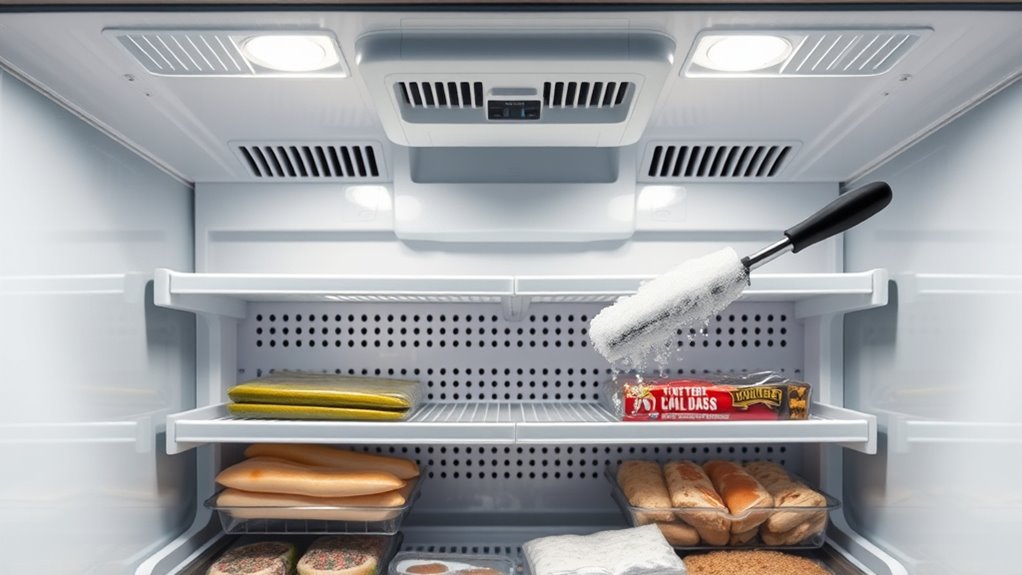
Thick ice buildup can block airflow and reduce your freezer’s efficiency, so keeping ice layers thin is key. You should defrost your freezer regularly to prevent excessive frost that makes it harder to maintain proper temperatures. By managing ice thickness and scheduling defrosts, you’ll keep your freezer running smoothly and save energy. Additionally, ensuring proper airflow within the unit is essential for safe and efficient operation. Proper air circulation helps prevent uneven cooling and further ice accumulation, prolonging the lifespan of your appliance.
Ice Thickness Impact
Ice thickness plays a critical role in your freezer’s efficiency by acting as an insulating layer that hampers heat transfer from the coils. When ice exceeds ¼-inch, it considerably impairs cooling performance, forcing the compressor to work harder and increasing energy use. Thick ice blocks airflow, causing uneven temperatures and storage issues. To prevent this, monitor ice buildup regularly and remove excess frost promptly. Proper organization, airtight containers, and minimal door openings help reduce moisture ingress. Additionally, proper airflow is essential for maintaining consistent temperatures and optimal freezer performance. Ensuring good air circulation prevents cold spots and improves energy efficiency. Below is a table illustrating how ice thickness impacts freezer function:
| Ice Thickness | Effect on Efficiency | Recommended Action |
|---|---|---|
| Less than ¼ inch | Minimal impact | Maintain regular defrosting |
| ¼ inch to ½ inch | Moderate impact | Schedule defrosting before performance drops |
| Over ½ inch | Severe impact | Defrost immediately to restore efficiency |
| Excessive buildup | Causes airflow blockages | Clear ice buildup promptly |
| Thin frost layer | Slight impact | Routine cleaning and inspection |
Defrosting Frequency Tips
Effective management of defrosting frequency is essential to maintaining your freezer’s ideal performance. You should follow manufacturer guidelines closely and adjust based on your usage environment. Freezers in high-humidity areas or with frequent door openings may need more frequent defrost cycles. For automatic defrost models, ensure the system runs as intended, and manually defrost at least every six months if needed. Keep an eye on frost buildup—more than ¼ inch thick or exceeding 5-10 mm indicates it’s time to defrost. To speed up the process, use fans or hot water pans, and avoid sharp tools. After defrosting, clean and dry interior surfaces before plugging in. Regularly inspect coils, seals, and defrost components to prevent unnecessary ice accumulation and maintain efficiency. Utilizing HEPA filtration in your environment can also help reduce excess moisture and frost formation inside your freezer.
Benefits of Manual and Automatic Defrosting
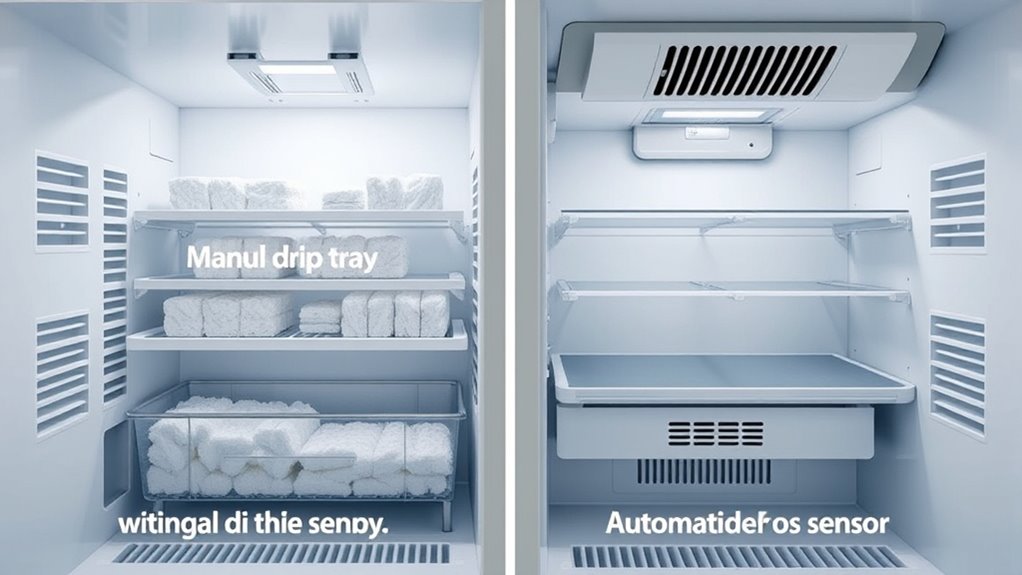
Choosing between manual and automatic defrosting methods impacts your freezer’s efficiency, maintenance, and food quality. Manual defrosting requires your intervention, which can lead to longer defrost times and increased labor. It may cause higher energy loss due to thicker frost buildup and inconsistent cooling cycles. On the other hand, automatic defrost systems, like hot gas or electric, operate on timers or sensors, reducing frost more efficiently—hot gas defrost, for example, clears frost approximately 1.5 times faster. These systems better control heater power, minimize temperature fluctuations, and prevent airflow blockages, maintaining consistent performance. Though automatic defrost may consume slightly more energy during cycles, it generally results in energy savings overall and helps preserve food quality by reducing temperature swings and frost accumulation. Implementing precise defrost controls can further optimize energy use and prolong the lifespan of your freezer.
Choosing the Right Freezer Model for Efficiency
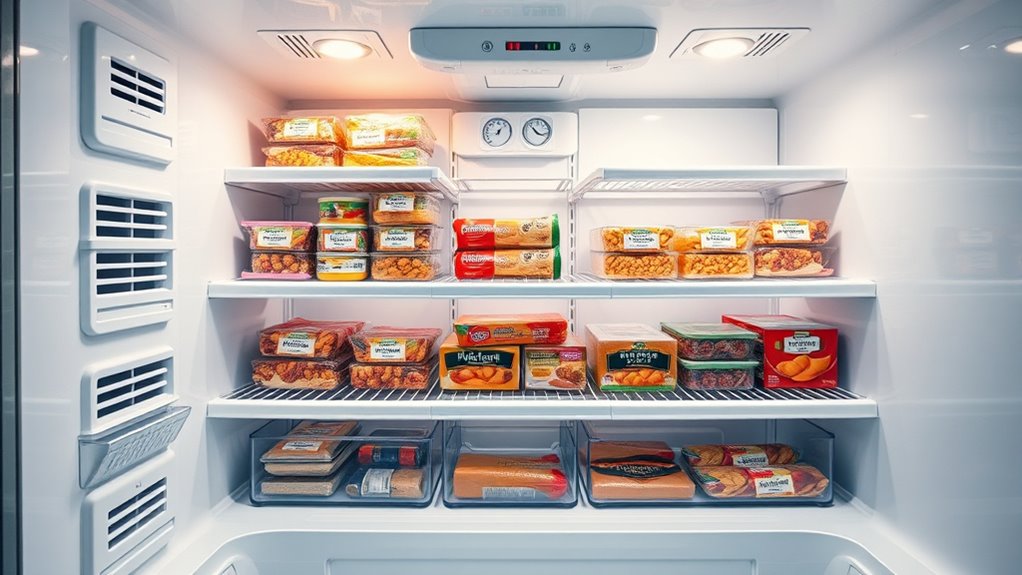
Selecting the right freezer model can substantially boost your energy efficiency and reduce long-term costs. When choosing, consider models like chest freezers, which retain cold air better and use insulation materials like polyurethane foam, cutting energy use by over 50%. Energy Star-rated freezers guarantee at least 10% better efficiency than standard models. Look for features such as multi-seal lids to minimize cold air loss and insulation thickness of 100mm or more for *ideal* thermal retention. Smaller freezers, matched to your storage needs, burn less energy, and high-efficiency models powered by AC or DC are *best suited* for off-grid setups. Incorporating whole-house water filtration systems can also enhance overall home efficiency by reducing maintenance needs and improving water quality. Additionally, maintaining proper load level and airflow within the freezer can significantly improve its performance and energy consumption.
Routine Maintenance for Peak Performance
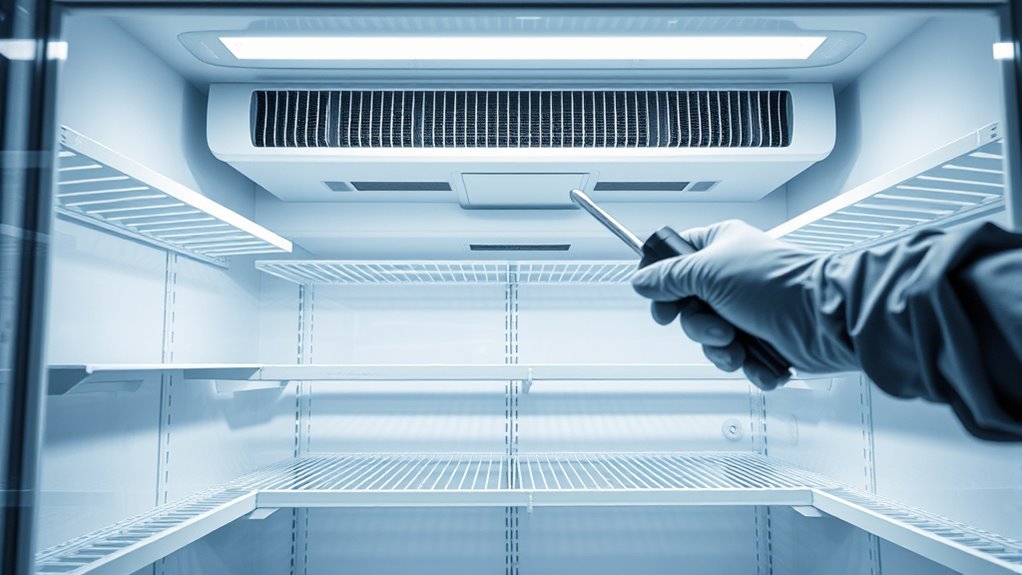
Routine maintenance is essential to keep your freezer running at peak performance and maximize energy efficiency. Regularly check frost buildup and defrost when it reaches about 5 millimeters. Plan defrost sessions during low inventory or after moving contents. Always unplug the freezer before defrosting to ensure safety. Use ice scrapers carefully to avoid damaging seals, and clean the interior thoroughly afterward, letting it dry before restocking. Inspect door gaskets for cracks and replace them immediately to maintain an airtight seal. Keep the exterior clean and ensure good airflow around the unit. Proper maintenance includes checking temperature settings, keeping the freezer half-full, and removing expired items. Additionally, regularly monitor the filter indicators if available to ensure optimal performance. Maintaining proper airflow around the freezer helps prevent overheating and promotes efficiency. Below is a quick guide:
| Task | Frequency | Tips |
|---|---|---|
| Defrosting | When frost exceeds 5 mm | Unplug before defrosting |
| Seal Inspection | Monthly | Replace damaged gaskets |
| Coil Cleaning | Biannually | Use gentle brushes, follow manufacturer guidelines |
Upgrading to Energy-Saving Freezer Technologies
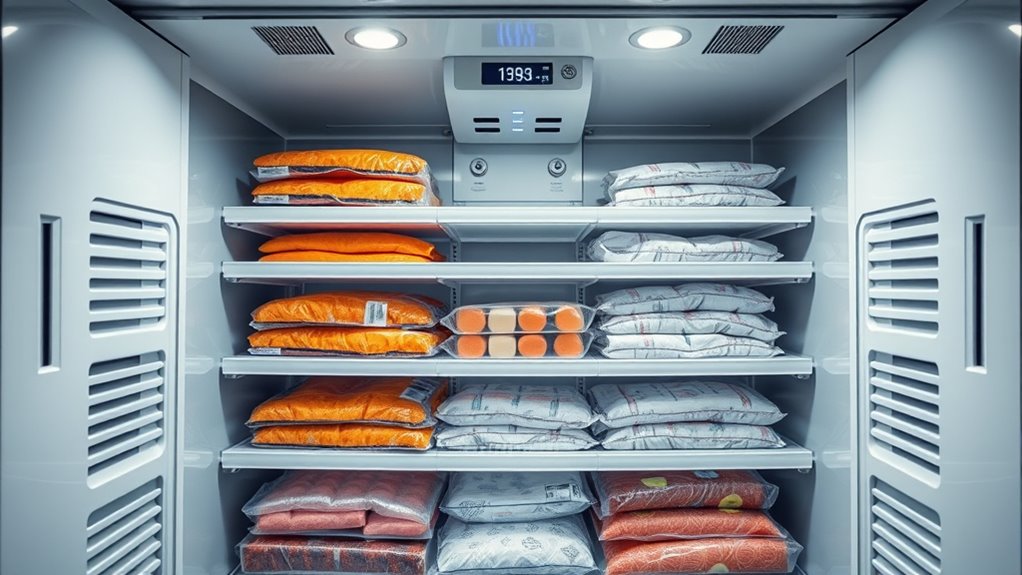
Have you considered how upgrading to energy-saving freezer technologies can dramatically cut your utility bills? Modern compressor innovations, like Linear Cooling and inverter systems, use 30-50% less energy while maintaining stable temperatures. These advanced compressors are USDA-certified for “Super Efficient Cold Storage,” ensuring significant savings and reliable operation. Additionally, improved insulation materials, such as vacuum panels, help reduce heat transfer, lowering power consumption and maintaining consistent temperatures. Smart control systems leverage AI and IoT connectivity to optimize compressor run times, adjust defrost cycles, and monitor energy use remotely. These technologies not only cut costs but also extend your freezer’s lifespan by minimizing system wear. Upgrading guarantees you’re leveraging the latest in energy efficiency, making your freezer smarter, greener, and more cost-effective.
Practical Tips for Sustained Freezer Efficiency
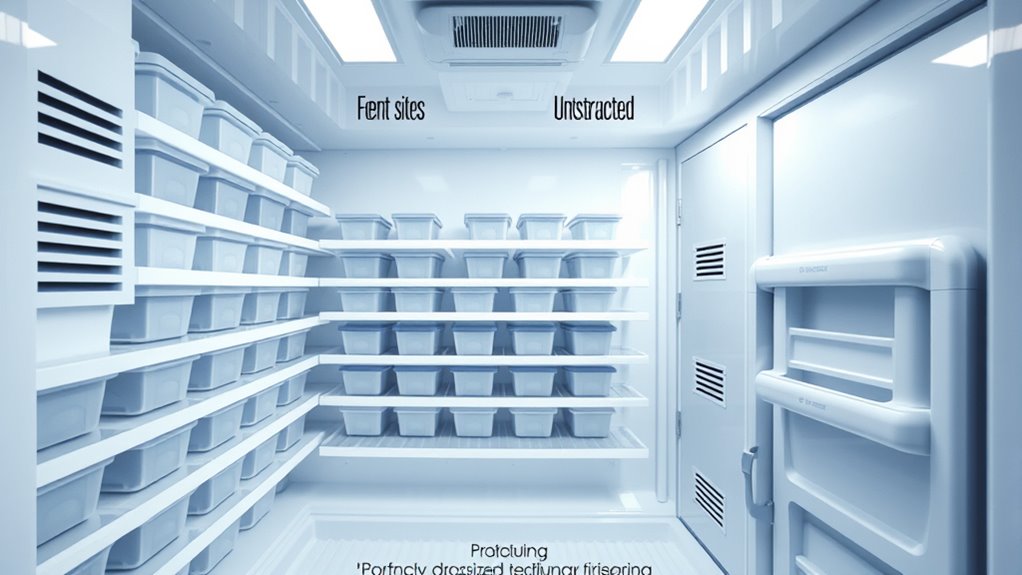
Maintaining essential load levels is crucial for sustained freezer efficiency because it minimizes warm air influx during door openings. Keep your freezer full or nearly full by adding non-food items like water bottles or newspapers if needed—this helps keep the cold in. Avoid overstuffing, which can block airflow and hinder proper cooling and thermostat accuracy. Regularly audit your contents, removing expired or unnecessary items to optimize load management. Guarantee good airflow by keeping space clear around the exterior and inside, avoiding blocking vents. Clean or replace filters at least twice a year to prevent dust buildup. Proper temperature monitoring with reliable tools helps catch irregularities early, maintaining steady efficiency. Additionally, using appropriate filtration can help protect internal components and ensure consistent operation. Ensuring the freezer maintains a consistent temperature also involves checking for symptoms of malfunction, which if ignored, could lead to decreased efficiency and potential damage. Manage frost buildup by defrosting when ice exceeds 0.25 inches, and always dry the interior afterward. Proper temperature monitoring with reliable tools helps catch irregularities early, maintaining steady efficiency.
Frequently Asked Questions
How Does Ambient Room Temperature Affect Freezer Efficiency?
You’ll notice that higher ambient room temperatures diminish your freezer’s efficiency because the compressor works harder to dissipate heat. This increased workload consumes more energy and accelerates wear on components. Hotter air also causes condensation or frost buildup, affecting internal temperatures and food quality. To maintain efficiency, place your freezer in a cool, well-ventilated spot, limit door openings, and ensure good airflow around it.
Can Storing Warm Items Damage My Freezer or Reduce Efficiency?
Storing warm items can damage your freezer and reduce efficiency. When you place hot food inside, it causes a temporary temperature spike, forcing the compressor to work harder and increasing energy use. Over time, this extra workload accelerates wear on components like the compressor and frost buildup, which may shorten your freezer’s lifespan. To protect your appliance and save energy, let food cool before freezing and avoid overloading.
What Is the Ideal Number of Times to Defrost a Freezer Annually?
An ounce of prevention is worth a pound of cure. You should defrost your freezer at least once a year to keep it running efficiently. If your model is older or experiences heavy use, consider doing it twice annually. Watch for frost over a quarter-inch or difficulty closing doors—that’s your cue. Regular defrosting prevents energy waste, mechanical issues, and keeps your freezer in top shape.
How Often Should I Check and Replace Door Seals?
You should check your door seals at least twice a year for signs of damage or leaks. If you notice cracks, tears, or difficulty closing the door properly, replace the gasket promptly. Regular inspections help prevent energy loss and spoilage. Depending on usage and wear, you might need to substitute the seal every 3 to 10 years. Keep the seals clean and lubricated to extend their lifespan and ensure an airtight fit.
Do Different Freezer Sizes Impact Energy Consumption Significantly?
Think of your freezer as a silent guardian, its size shaping how much energy it consumes. Larger freezers act like a bustling city, constantly running to keep everything cold, while smaller ones are like cozy cottages, efficient and less demanding. Your choice impacts annual energy use profoundly—big freezers cost more to operate. Matching your freezer size to your needs ensures you don’t waste energy, keeping costs down and efficiency high.
Conclusion
So, after all this, you might think keeping your freezer efficient is a breeze. Ironically, it’s often about doing less—less door opening, less frost buildup, less chaos. Yet, in trying to simplify, you end up obsessively managing every detail. Maybe the real secret is just embracing the chaos, knowing that even the most perfectly organized freezer can’t escape the whims of time and temperature. Efficiency, after all, is a delightful illusion.
